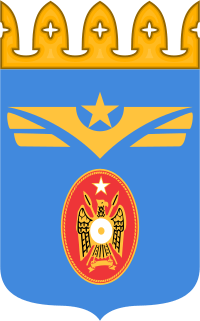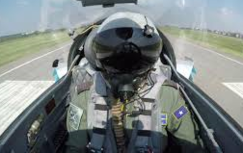Somali Air Force
The Somali Air Force (SAF; Somali: Ciidamada Cirka Soomaaliyeed, CCS; Arabic: القوات الجوية الصومالية, Al-Qūwāt al-Gawwīyä as-Ṣūmāl) is the air force of Somalia. The Somali Aeronautical Corps (SAC) was the name of the Somali Air Force during the pre-independence (1954–1960) period. After 1960, when Somalia gained independence, the name changed to the Somali Air Force. SAF principal organizer and the first Somalia pilot Ali Matan Hashi became the founder as well as the Chief of SAF.[2] The SAF at one point had the strongest airstrike capability in the Horn of Africa.[3] Following the fall of the government in the early 1990s, the air force disbanded. A reconstituted Somali Central Government later relaunched the SAF in the 2010s, with its headquarters being reopened in 2015.[4]
| Somali Air Force | |
|---|---|
| Ciidamada Cirka Soomaaliyeed | |
 Coat of arms of the Somali Air Force | |
| Founded | 1954 |
| Country | |
| Allegiance | |
| Type | Air force |
| Role | Aerial warfare |
| Part of | Somali Armed Forces |
| Headquarters | Afsione, near Mogadishu International Airport |
| Motto(s) | Somali: Isku Tiirsada! English: Lean Together! |
| Colors | |
| Engagements | 1964 Ethiopian–Somali Border War Shifta War Ogaden War 1982 Ethiopian–Somali Border War |
| Commanders | |
| Chief of the Air Force | |
| Chief of Armed Forces | |
| Notable commanders | |
| Insignia | |
| Roundel |  |
History
Following an agreement signed between the Somali and Italian governments in 1962, Somali airmen began a training regimen in Italy with the assistance of Italian technical staff and pilots.[5] Over the same period, fifty Somali cadets also commenced training in Soviet Union as jet aircraft pilots, later to be joined by more than two hundred of the nation's elite NCOs and officers for general military training.[6] Most of these personnel then returned to Somalia with the skills and knowledge that they had acquired abroad.
The Corpo Aeronautico della Somalia was established in the 1950s, and was at first equipped with a small number of Western aircraft, including two Douglas C-47 Skytrains, eight Douglas C-53 Skytrooper Dakota paratroop variants, two Beech C-45 Expeditors for transport tasks, two North American T-6 Texans (H model), two Stinson L-5 Sentinels, and six North American P-51 Mustangs used as fighter aircraft. However, all the surviving Mustangs were returned to Italy before Somalia gained its independence in June 1960.[7] The Aeronautical Corps was officially renamed as the Somali Air Force in December 1960.[8] Two Gomhouria light aircraft soon arrived from Egypt, and then later eight Piaggio P.148 trainers were donated by Italy in 1962.[8]
On 15 October 1969, while paying a visit to the northern town of Las Anod, Somalia's then President Abdirashid Ali Shermarke was shot dead by one of his bodyguards. His assassination was quickly followed by a military coup d'état on October 21, 1969 (the day after his funeral), in which the Somali Army seized power without encountering armed opposition — essentially a bloodless takeover. The putsch was spearheaded by Major General Mohamed Siad Barre, who at the time commanded the army.[9] Barre then proclaimed Somalia to be a socialist state, and rapid modernization programs soon followed suit. Numerous Somali airmen were subsequently sent to train abroad in countries such as the United States, Italy, the Soviet Union, and the United Kingdom. After their training, many of these men went on to become the nation's leading instructors and fighter pilots. 50 MiG-17s were donated by the Soviets, while 29 MiG-21MFs were purchased by the Somali government. After the Ogaden War the Somali Air Force was depleted and received support from China in the form of 30 MiG-19 fighters.
Asli Hassan Abade was the first female pilot in the Somali Air Force. She received training on single prop aircraft, and later earned a scholarship to study at the United States Air Force Academy.
Ogaden War (1977–1978)
In July 1977, the Ogaden War broke out after Siad Barre's government sought to incorporate the predominantly Somali-inhabited Ogaden region in Ethiopia into a pan-Somali Greater Somalia.[10] The Somali Armed Forces invaded the Ogaden and was successful at first, capturing most of the territory. The tide began to turn with the Soviet Union's sudden shift of support to Ethiopia, followed by almost the entire communist world siding with the latter. The Soviets halted their previous supplies to Barre's regime and increased the distribution of aid, weapons, and training to Ethiopia's newly-communist Derg regime. They also brought in around 15,000 Cuban troops to assist the Ethiopian military. By 1978, the Somali troops were pushed out of the Ogaden.
Before the war Somalia acquired four Ilyushin Il-28 "Beagle" bombers. Flown by MiG-17 pilots, the aircraft had the potential to be decisive back when they first arrived. Only three Il-28s remained in service by the time the war. They would support the initial invasion, but they were fairly ineffective thanks to the decision to make high-altitude bombing runs. Once the Ethiopian Air Force began to contest the skies, the Il-28s were withdrawn from combat, remaining at their airfields until Ethiopian air strikes took them out. After the end of war none of the Il-28s survived the war.[11]
Status in 1980-81
Nelson et al stated in 1980 that sources indicated that of approximately twenty-one Somali combat aircraft, less than a half dozen — MiG—17s and MiG—21s — were kept operational by Pakistani mechanics.[12] Six Italian single-engine SIAI Marchetti SF—260W trainer tactical support aircraft delivered in late 1979 were reportedly grounded in 1980 because of a lack of 110-octane gasoline in Somalia for the piston-engined aircraft. It was reported that the shortage of combat aircraft was being redressed in 1981 when that thirty Chinese Shenyang J-6 fighter-bombers were beginning to arrive.
Equipment
Somali Air Force servicemen wore green flight suits with shoulderboards indicating their rank alongside a visored pilot mask and helmet when actively flying. The Air Force would traditionally wear a sky blue (for summer) or navy blue service shirt, navy blue trousers, beret or sidecap, shoulderboards and black boots[13] however a more formal uniform would consist of a navy blue peaked cap, blazer, trousers, black formal shoes and tie and sky blue shirt, Air Force servicemen would wear ribbons on their left breast as well as Air Force insignia.[14]
Nelson et al estimated the Somali Air Force's aircraft in 1981 as:
.jpg)
| Type | Description | Country of Manufacture | Inventory |
|---|---|---|---|
| Combat aircraft | |||
| MiG-17 "Fresco" | Mach 0.9 fighter-bomber | 27[15] | |
| MiG-21MF "Fishbed J" MiG-21bis Fishbed L | Mach 2.1 fighter-bomber with AA-2 Atoll anti-aircraft missiles | 9[16] or 29 | |
| Shenyang J-6 | Mach 1.3 fighter-bomber | 30 | |
| Aermacchi SF.260W | Single-engine light attack craft | 6 | |
| Hawker Hunter | ground attack fighter/reconnaissance/trainer aircraft | 8 | |
| Transport aircraft | |||
| Antonov An-2 "Colt" | Single-engine light transport | 3 | |
| An-24/-26 | Twin-turboprop transport | ||
| Douglas C-47 Skytrain | Twin-engine transport | ||
| C-45 | Twin-engine light transport | 1 | |
| Aeritalia G.222 | Twin-turboprop transport | 4 | |
| Helicopters | |||
| Mi-4 | Twelve-seat transport | 4 | |
| Mi-8 | Twin-engine medium transport | 8 | |
| AB-204 | General utility helicopter | 1 | |
| AB-212 | 4 | ||
| Trainers | |||
| MiG-15 UTI | Two-seat advanced jet trainer | 4 | |
| MiG-21UM Mongol B | Two-seat advanced jet trainer | 20 | |
| Yak-11 | Single-engine, two-seat advanced trainer | ||
| P.148 | Single-engine, two-seat primary trainer | 6 | |
| SM-1019 | Single-engine training, observation, and light attack aircraft | ||
An Air Defence Command - seemingly a fourth service - was formed by the late 1980s. In 1987, according to U.S. DIA records, it was 3,500 strong, headquartered at Mogadishu, with seven AA gun/SAM brigades and one radar brigade.[17] Eight years later, the Somali Air Defence Force operated most of the surface-to-air missiles. As of 1 June 1989, the IISS also estimated that Somali surface-to-air defence equipment included 40 SA-2 Guideline missiles (operational status uncertain), 10 SA-3 Goa, and 20 SA-7 surface-to-air missiles.[18] On 28 October 1985 one Somali MiG-21 crashed.[16]
The Library of Congress Country Studies wrote in 1992-93 that: "..there [were] numerous unconfirmed reports of Somali-South African military cooperation. The relationship supposedly began on December 18, 1984, when South African foreign minister Roelof "Pik" Botha visited Somalia and conducted discussions with Siad Barre. The two leaders reportedly signed a secret communique granting South African Airways landing rights in Somalia and the South African navy access to the ports of Chisimayu and Berbera. It was said that Somalia also agreed to sell South Africa eight MiG-21 fighters. In exchange.. South Africa supposedly arranged to ship spare parts and ammunition for the Hawker Hunter aircraft supplied to Somalia by the United Arab Emirates, and to be responsible for the salaries of ten former Rhodesian Air Force pilots who already were in Somalia helping to train Somali pilots and technicians and flying combat missions in the north."[19]
Dissolution
By the time President Siad Barre fled the capital Mogadishu for his home region of Gedo in January 1991, the air force had effectively dissolved amid the Somali Civil War. In 1993, eight MiG-21 (six MiG-21MF and two MiG-21UM), three MiG-15UTI, one SF-260W and unknown MiG-17 wrecks were seen at Mogadishu airport.[20][21] Three Hawker Hunters, serialled 704, 705, and 711, were seen at Baidoa Airport by Australian forces during the UNOSOM II intervention, but were later removed.[22]
Relaunch
During the decades of the Somali Civil War, former members of Barre's vanished air force maintained contact with each other. On October 29, 2012, 40 senior Somali National Army and Air Force officers participated in the three-day Improving Understanding and Compliance with International Humanitarian Law (IHL) workshop in Djibouti, organized by AMISOM.[23] In October 2014, Somali Air Force cadets underwent additional training in Turkey.[24]
On 1 July 2015, the Somali Defence Minister Abdulkadir Sheikh Dini reopened the headquarters of the Somali Air Force. Located in Afisone, Mogadishu, the move is aimed to facilitate the re-establishment of the air force after 25 years of civil war.[4]
The air force is not currently operational and has no aircraft. It is composed of approximately 170 personnel (40-50 officers ranging from second lieutenant to colonel and 120-130 non-commissioned officers and airmen). Turkey is delivering residential training to a group of young Somali air force personnel and intends to support the development of an aviation capability. The potential cumulative cost to develop a Somali air arm again, over 10 years would be $50 million.[25]

On the 6th March 2020, Brigadier General Sheikh Ali met with Air Chief Marshal Mujahid Anwar Khan in Islamabad to discuss cooperation efforts and bilateral ties between the Somali Air Force and the Pakistani Air Force.[26][27]
Ranks of the Somali Air Force
- Officers
| Equivalent NATO code | OF-10 | OF-9 | OF-8 | OF-7 | OF-6 | OF-5 | OF-4 | OF-3 | OF-2 | OF-1 | OF(D) and student officer | |||||||||||||||||||||||||
|---|---|---|---|---|---|---|---|---|---|---|---|---|---|---|---|---|---|---|---|---|---|---|---|---|---|---|---|---|---|---|---|---|---|---|---|---|
(Edit) |
No equivalent |
 |
 |
 |
 |
 |
 |
 |
 |
No equivalent | ||||||||||||||||||||||||||
| Major General | Brigadier General | Colonel | Lieutenant Colonel | Major | Captain | First Lieutenant | Second Lieutenant | |||||||||||||||||||||||||||||
- Enlisted
| Equivalent NATO code | OR-9 | OR-8 | OR-7 | OR-6 | OR-5 | OR-4 | OR-3 | OR-2 | OR-1 | |||||||||||||||||||||||||||
|---|---|---|---|---|---|---|---|---|---|---|---|---|---|---|---|---|---|---|---|---|---|---|---|---|---|---|---|---|---|---|---|---|---|---|---|---|
(Edit) |
 |
 |
 |
 |
No equivalent | No insignia | ||||||||||||||||||||||||||||||
| Chief Warrant Officer | Warrant Officer Class 1 | Warrant Officer Class 2 | Warrant Officer Class 3 | Sergeant | Corporal | Lance Corporal | Aircraftman | |||||||||||||||||||||||||||||
Notes
- "African Aerospace - Somalia battles for an air force to fight against terror". Africanaerospace.aero. 2018-03-07. Retrieved 2020-05-23.
- Luigi Pestalozza, The Somalian Revolution, (Éditions Afrique Asie Amérique latine: 1974), p.27.
- The Soviet Union in the Horn of Africa: the diplomacy of intervention and Disengagement by Robert G Patman - p. 184
- "Somalia Reopens Air Force Headquarter". Goobjoog News. 1 July 2015. Archived from the original on 3 July 2015. Retrieved 3 July 2015.
- Italy. Centro di documentazione, Italy. Servizio delle informazioni, Italy; documents and notes, Volume 14, (Centro di documentazione: 1965), p.460.
- John Gordon Stewart Drysdale, The Somali dispute, (Pall Mall Press: 1964)
- Cooper 2015, p. 13.
- Cooper 2015, p. 14.
- Moshe Y. Sachs, Worldmark Encyclopedia of the Nations, Volume 2, (Worldmark Press: 1988), p.290.
- Cooper 2015.
- "/k/ Planes — /k/ Planes Episode 94: Cripple Fight!". Kplanes.tumblr.com. 2016-02-26. Retrieved 2020-05-23.
- Somalia: A Country Study -Mission, Organization, and Strength
- https://secureservercdn.net/198.71.233.44/tbo.ded.myftpupload.com/wp-content/uploads/taliyaha-ciidanka-cirka-somalia.png?time=1584553927
- https://www.caasimada.net/wp-content/uploads/2020/03/WhatsApp-Image-2020-03-04-at-6.44.46-AM.jpeg
- "Jan J. Safarik: Air Aces Home Page". Aces.safarikovi.org. Retrieved 2020-05-23.
- "Mikojan MiG-21 Użytkownicy cz. 2". samolotypolskie.pl. Retrieved 2020-05-23.
- http://www.dia.mil/FOIA/FOIA-Electronic-Reading-Room/FOIA-Reading-Room-Africa/FileID/39704/
- IISS Military Balance 1989–90, Brassey's for the IISS, 1989, 113.
- Helen Metz (ed.), A Country Study: Somalia, 1993, 213.
- "Wrecked aircraft at the airbase formerly used by the Somalian Aeronautical Corps and now by the Unified Task Force in Somalia". awm.gov.au. The Australian War Memorial. Retrieved 2020-05-23.
- "The remains of six irreparable Somali Air Force Mig fighter aircraft on the edge of the airport ..." awm.gov.au. The Australian War Memorial. 2020-03-24. Retrieved 2020-05-23.
- "Hawker Hunter squadron left in the dessert. - Aviation - HMVF - Historic Military Vehicles Forum". HMVF. Retrieved 2020-05-23.
- "AMISOM offers IHL training to senior officials of the Somali National Forces". AMISOM. Archived from the original on 1 January 2016. Retrieved 23 November 2012.
- "Somali air force cadets in Turkey". Somalia Newsroom. 23 October 2013. Archived from the original on 3 July 2015. Retrieved 9 May 2015.
- "Somalia Security and Justice Public Expenditure Review" (PDF). World Bank. 31 January 2017. Archived (PDF) from the original on 10 August 2017. Retrieved 20 May 2018.
- "Somali Air Force commander visits Air Headquarters". Dailytimes.com.pk. 2020-03-05. Retrieved 2020-05-23.
- https://sonna.so/en/pakistan-offers-support-to-somalia-for-military-training/
References
- Cooper, Tom (April 19, 2015). Wings over Ogaden: The Ethiopian-Somali War (1978-1979). Africa @ War. Solihull: Helion. ISBN 978-1909982383.
- World Aircraft Information Files Brightstar publishing London File 338 sheet 4
- WorldAirForces.com, Historical Somali Aircraft
External links
- Court Chick & Albert Grandolini, with Tom Cooper & Sander Peeters, Somalia, 1980-1996, Air Combat Information Group, September 2, 2003.
- Somali Hunters
- https://aviation-safety.net/database/record.php?id=19601011-0 - Beechcraft missing report 1960
- https://wikileaks.org/plusd/cables/1975MOGADI01551_b.html change of air force chief, 1975